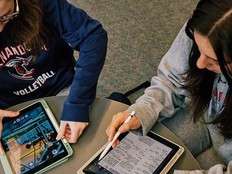Kinect for Windows Hits the Classroom
In Jeremy Gibson's Immersive Game Design course, students at the University of Southern California use Microsoft's Kinect for Windows motion sensing input device on PCs to "shake things up" — literally.
The idea, says Gibson, a member of the Interactive Media faculty in the School of Cinematic Arts, is for students to create new experiences and think about interacting in different ways through active hand and arm gestures.
"Pushing a bunch of students used to developing traditional games to create a new kind of experience is a goal in itself," says Gibson, because many of them are used to designing games using a standard mouse and keyboard or joystick controller. "Using Kinect means that everything the students know about how to control a game changes when their whole body is the controller," he explains.
The Kinect for Windows sensor became available in February after the commercial version was demonstrated at the Consumer Electronics Show in January, says Kent Foster of Microsoft Game Studios, who serves as director of university incubations and outreach.
The sensor attaches to a PC and lets users direct the computer's functions by waving their hands. Kinect for Windows also features "near mode," which lets the sensor's camera see objects as close as 40 centimeters in front of the computer without losing accuracy or precision, Microsoft says.
Microsoft has seen Kinect for Windows used in many ways — for instance, in hospitals, in classrooms and even at auto shows — and envisions future opportunities with anything that requires hands-free tracking and interaction with a sensor, says Foster.
"There are even experiments that have been done in universities using Kinect for home monitoring and gesturing to turn lights on," says Foster. "The imagination goes wild when you let researchers and students think about all the ways you can use Kinect in many different contexts."
Kinect is Microsoft's chance to take back the luster of personal technology from competing brands, says Chris Silva, an industry analyst at Altimeter Group. "With Kinect, Microsoft is changing the way we interact with our machines, and that's something that has already started with mobile devices," through the use of voice recognition, image recognition and finger gestures.
Kinect with New Experiences
At Gibson's design course at USC, interdisciplinary teams of four to five students are given prompts and asked to come up with a novel experience that is not meant to be a commercially viable or specific game, but rather, an artistic or otherwise interesting experience.
Three years ago, Gibson began teaching this class in partnership with Michael Zyda, director of the GamePipe Laboratory at USC's Viterbi School of Engineering. The class has evolved every year since, Gibson says.
Kinect is also used in several other projects at the university, Gibson says. For example, a Masters in Fine Arts student is working with this technology for her thesis project, called Songlines, in which players create a virtual world and music to accompany the scene through full-body Kinect input.
The point of using Kinect is not so much to create specific games or apps, but rather to explore the process of creating and "thinking about different ways we control games and different ways we can create experiences," Gibson says.
"One of the things we try to do is give students experience working with things that push the envelope, and Microsoft Kinect fits that very, very well."







